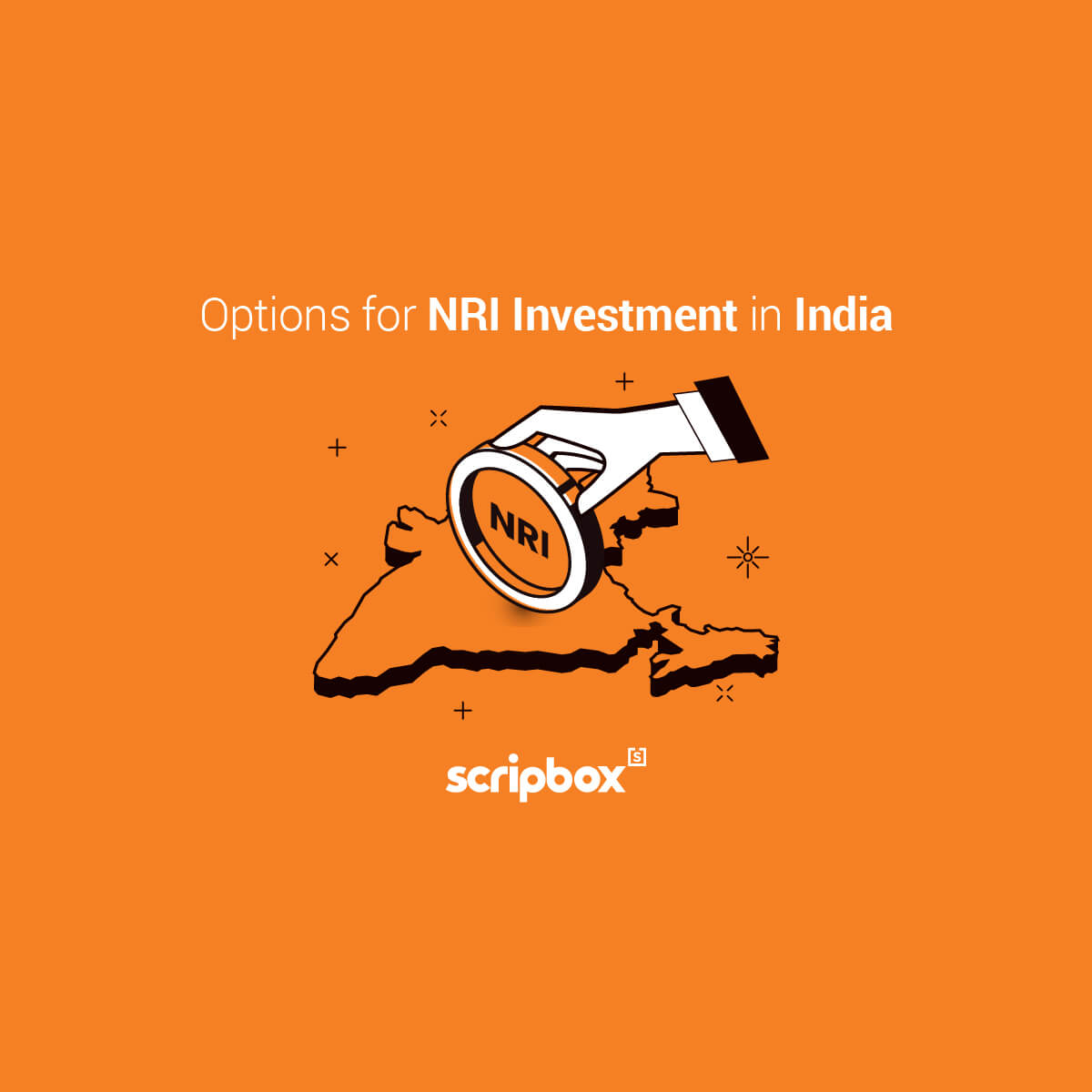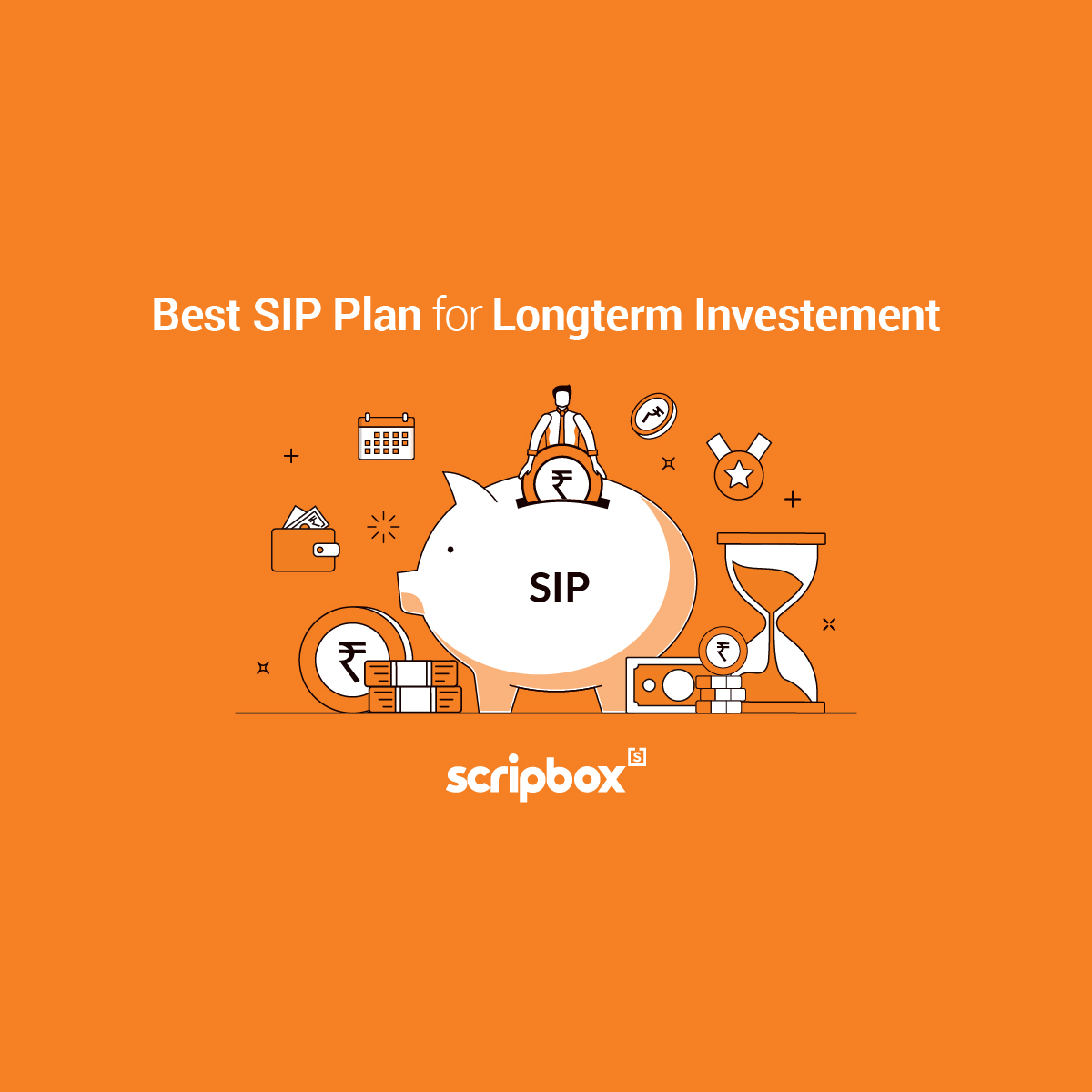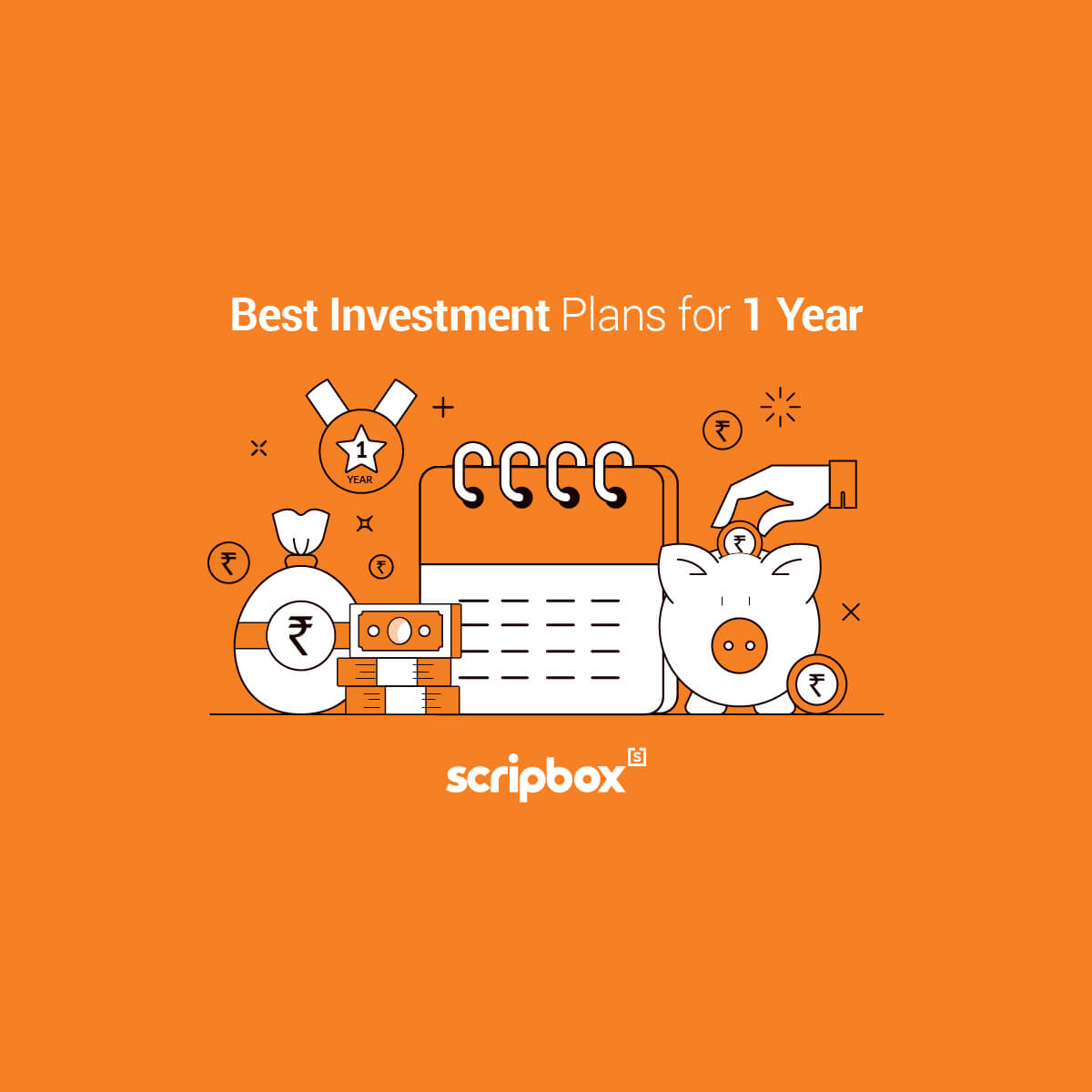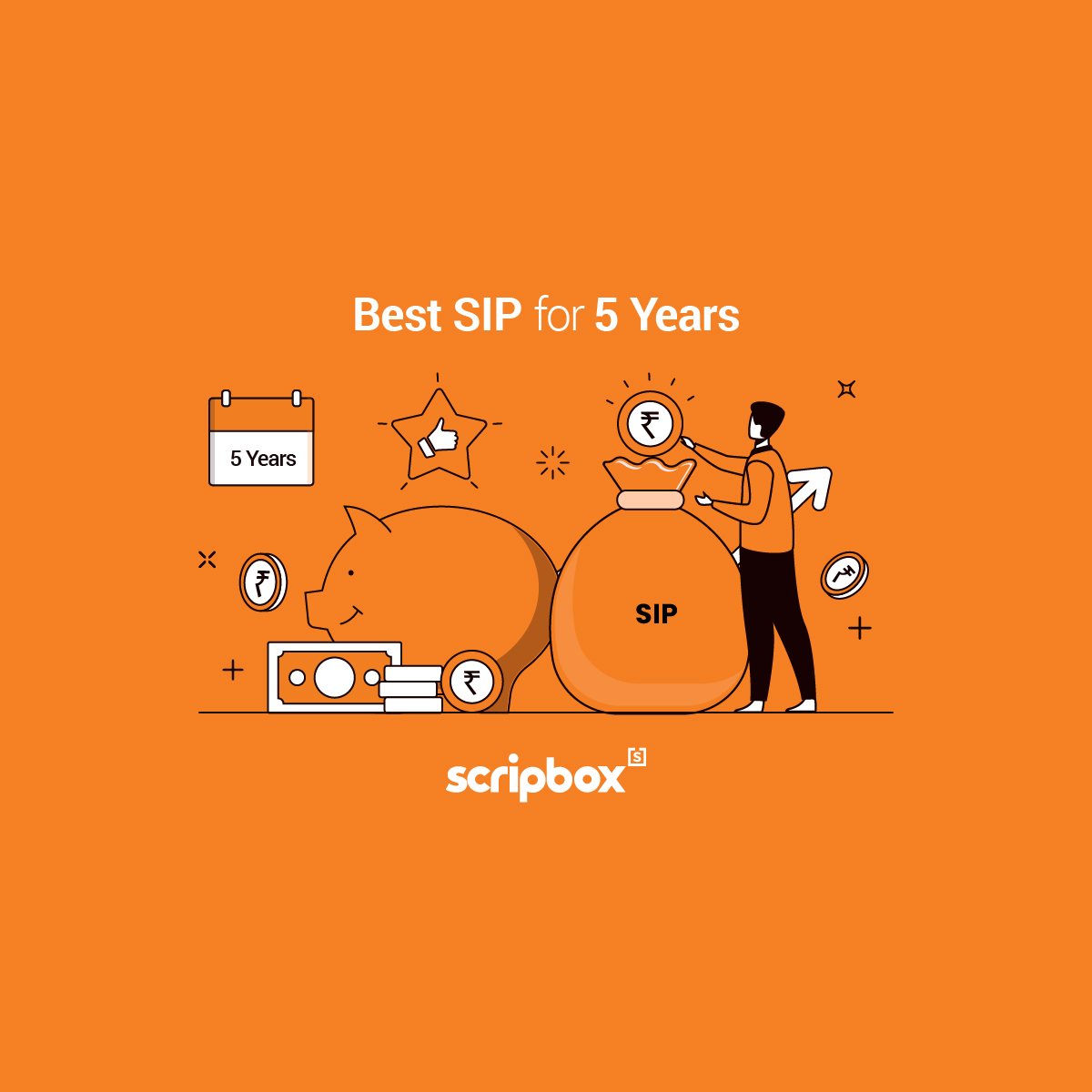The best investment plan for every investor can be different. What suits one investor might not suit the other mainly because their goals, financial situation, and risk tolerance levels vary. Though every investor is unique, we have categorised them based on goals, investment duration and financial situation. Following are some of the best investment options in 2025 for different kinds of investors.
Best Investment Plan in India 2025
| Investment Options | Best for | Returns Rate |
| Bank Fixed Deposit | Best for Short-Term Investment | 3.50% to 9.00% p.a. |
| National Savings Certificate (NSC) | Best for 5 years | 7.70% p.a. |
| Short Term Mutual Funds | Best for 3 Years | 6% – 8% p.a. |
| Ultra-Short Term Funds | Best for 1 Year | 3% – 5% p.a. |
| Post Office Monthly Income Scheme | Best for Monthly Income | 7.40% p.a. |
| Child Mutual Funds | Best for Child Future | 10% – 15% p.a Market Linked |
| Mutual Fund SIP Plans | Best for a Salaried Person | 10% – 15% p.a Market Linked |
| Senior Citizen Savings Scheme (SCSS) | Best for Senior Citizen | 8.20% p.a. |
| Sukanya Samriddhi Yojana (SSY) | Best for Girl Child | 8.20% p.a. |
| National Pension Scheme (NPS) | Best for Retirement | 9.00% to 12.00% p.a. |
| Debt mutual funds | Best for Beginner | 7-9%, market-linked |
| Public Provident Fund (PPF) | Best for Long term Investment | 7.10% p.a. |
Best Short Term Investment Option
| Investment Options | Rate of Return (in % p.a) |
| Liquid Funds | 5% |
| Corporate Deposits | 5%-7% |
| Bank Fixed Deposit | 3.5-7.25% |
| Recurring Deposits | 4.25-7% |
| Post-Office Time Deposits | 5.5-6.7% |
NOTE:
- Mutual fund returns are based on historical growth rates
- Returns from Bank Deposits and Post Office Deposits are average estimates of the prevailing rates.
Recommended Read: Best Short Term Investment Plans
Who Should Invest
- Short term investment options are suitable if you are looking for foreseeable returns. Furthermore, these schemes offer good liquidity.
- If you have an investment duration ranging from three years to five years, then short-term investment options are ideal for you. For example, saving up for a vacation or a vehicle purchase.
- If you are a risk-averse investor, these investment options will help you generate stable returns. Also, these schemes offer good diversification if your portfolio is already equity-focused.
Explore Scripbox Cash Management for Short Term Investment Plans
Best Investment Plan for 5 Years
| Investment Options | Rate of Return (in % p.a) |
| Large Cap Mutual Funds | 12.00% to 15.00% p.a. |
| ELSS Mutual Funds | 12.00% to 30.00% p.a. |
| Arbitrage Funds | 4-5% |
| Fixed Maturity Plans | 8-9% |
| Dynamic Bond Funds | 7% |
| Income Funds | 6-7% |
| Corporate Bond Funds | 5.5-7.5% |
| Tax Saving Fixed Deposit | 5-6% |
| Recurring Deposit | 4.25%-7% |
| Post Office Time Deposit | 6.90% to 7.50% p.a. |
| Post Office Monthly Income Scheme | 7.40% p.a. |
| National Savings Certificate (NSC) | 7.70% p.a. |
NOTE:
- Mutual fund returns are based on historical growth rates
- Returns from Bank Deposits and Post Office Deposits are average estimates of the prevailing rates.
Who Should Invest
- Some of the 5 Year investment plans like National Savings Certificate, Tax Saving FD, and ELSS Funds are ideal for tax saving purposes. Investments in these schemes qualify for tax deduction under Section 80C of the Income Tax Act.
- A couple of investment options listed above have a lock-in period of 5 years. Therefore, they are ideal for building a corpus at the end of the investment tenure. Suitable for goals such as buying a house (booking amount), vehicle, etc.
- If you are a moderate to low-risk taker, you can consider investing in any of the above schemes. However, make sure the scheme’s and your risk levels are aligned.
Explore: Scripbox Long Term Portfolio: for five-year Investment Plans
Best Investment Plan for 3 Years
| Investment Options | Rate of Return (in % p.a) |
| Liquid Funds | 4.50% to 7.50% p.a. |
| Short Term and Ultra Short Term Funds | 6-8% |
| Low Duration Funds | 3-6% |
| Fixed Deposits | 3.50% to 9.00% p.a. |
NOTE:
- Mutual fund returns are based on historical growth rates
- Returns from Bank Deposits are average estimates of the prevailing rates.
Who Should Invest
- The 3-year investment plans are suitable if you are a risk-averse to moderate risk-taker seeking stable or foreseeable returns.
- The investment options are mostly debt-oriented and hence are not highly risky. On the other hand, large-cap and ETFs/ index funds are equity funds that offer more or less stable returns when compared to other equity schemes.
- These investment options are ideal for goals such as loan/ debt payments, travel, home improvements, etc.
Best Investment Plan for 1 Year
| Best for 1 Year Investment | Highest Rate of Return (in % p.a) |
| Liquid Funds | 4% |
| Ultra-Short Term Funds | 3-5% |
| Low Duration Funds | 3-6% |
| Fixed Deposits | 7.25% |
| Recurring Deposits | 4.25-7% |
NOTE:
- Mutual fund returns are based on historical growth rates
- Returns from Bank Deposits are average estimates of the prevailing rates.
Who Should Invest
- The best investment plan for 1 year is highly liquid investment options that are suitable for creating an emergency corpus. These are good alternatives for holding liquid cash or money in a savings bank account.
- Though these debt schemes do not guarantee returns, they offer stable or foreseeable returns. Therefore, they help you plan your investments and goals in advance.
- If you are a risk-taker or a risk-averse investor, creating an emergency fund is a must. Hence, investing in one of the above schemes will help you create a good emergency fund.
Explore Scripbox Emergency Fund: for 1 Year Investment Plan
Best Investment Plan for Monthly Income
| Investment Options | Rate of Return (in % p.a) |
| Monthly Income Fixed Deposit | 3.50% to 9.00% p.a. |
| Post Office Monthly Income Scheme | 7.40% p.a. |
| Senior Citizen Savings Scheme | 8.20% p.a. |
| Long-Term Government Bonds | 3.89% |
| Pradhan Mantri Vaya Vandana Yojana (PMVVY) | 8.00% p.a. |
| FD Annuity Scheme | 6% |
| Mutual Funds – Systematic Withdrawal Plans | Depends on your mutual fund investments. |
NOTE:
- Mutual fund returns are based on historical growth rates
- Returns from Bank Deposits and Post Office Deposits are average estimates of the prevailing rates.
Who Should Invest
- If you are a retired individual, freelancer, or anyone who is seeking regular monthly income can invest in the monthly income schemes. These schemes help you generate a steady flow of income.
- These are debt schemes that offer guaranteed or stable returns. Since the main focus of this scheme is capital protection, the returns are often lower when compared to equity funds.
- The risk associated with the scheme is very less, and hence if you are a risk-averse investor, this scheme will be an ideal option for you.
Explore Scripbox Retire Growing Income Plan: for Monthly Income Plan
Best Investment Plan for Child’s Future
| Best for Child Future | Rate of Return (in % p.a) |
| Children’s Mutual Funds | 10-15%, market-linked |
| Mid Cap Funds | 10-15%, market-linked |
| Large and Mid-Cap Funds | 10-15%, market-linked |
| Multi-Cap/ Flexi Cap Funds | 10-12%, market-linked |
| Gold Funds | 7-8% |
| International Mutual Funds | 10-15%, market-linked |
| Public Provident Fund (PPF) | 7.10% p.a. |
| Sukanya Samriddhi Yojana (SSY) | 8.20% p.a. |
NOTE:
- Mutual fund returns are based on historical growth rates
Who Should Invest
- Child plans help you save for your child’s future. If you are looking to invest in a secure future for your child, these schemes are ideal.
- Often, planning for your child’s future is a long term goal (10-15 years), and hence equity investments can help you generate significant returns. On the other hand, some low-risk and guaranteed income schemes will help you create a good corpus at the end of the investment tenure.
- Based on your risk appetite, you can choose the best option to secure your child’s future.
Explore Scripbox Child Advantage: for Child Future Plan
Best Investment Plan for a Salaried Person
| Investment Options | Rate of Return (in % p.a) |
| SIP in ELSS tax-saving funds | 10-15%, market-linked |
| SIP in equity mutual funds | 10-15%, market-linked |
| Hybrid mutual funds | 10-12%, market-linked |
| Debt mutual funds | 7-9%, market-linked |
| Tax-saving fixed deposits | 6.80% |
| Recurring Deposits | 4.50% to 8.25% p.a. |
| National Pension Scheme (NPS) | 9.00% to 12.00% p.a. |
| Public Provident Fund (PPF) | 7.10% p.a. |
NOTE:
- Mutual fund returns are based on historical growth rates
- The tenure for ELSS, equity and hybrid funds is taken as 5-7 years.
- The tenure for recurring deposits is taken as 3-7 years
- The tenure for debt mutual funds is 1-3 years
Who Should Invest?
- The above investments suit investors who aim to invest small amounts on a regular basis.
- For the salaried class, tax saving is also an important goal. To ensure tax-saving and investment purposes are met, one can consider investing in ELSS funds, PPF, NPS, and tax-saving FDs.
- The ideal investment horizon for the above investments varies between 1 to 15+ years. For investments like debt funds, the investment horizon is 1-3 years. However, for PPF and equity funds, a long-term investment horizon is required.
Explore Scripbox Dream Planner: for a Salaried Person
Best Investment Plan for Senior Citizens
| Investment Options | Rate of Return (in % p.a) |
| Debt Funds | 7-9%, market-linked |
| Senior Citizen Fixed Deposits | 7.50% |
| Senior Citizen Savings Scheme (SCSS) | 8.20% p.a. |
| Post Office Monthly Income Scheme (POMIS) | 7.40% p.a. |
| Pradhan Mantri Vaya Vandana Yojana (PMVVY) | 8.00% p.a. |
NOTE:
- Mutual fund returns are based on historical growth rates
- The tenure for debt mutual funds is 1-3 years
- The tenure for Senior Citizen FDs is considered to be 1-5 years
- The average return for a tenure of 10 years for PMVVY is 8%
Who Should Invest?
- The above investments suit senior citizens who aim to generate regular income through their investments.
- The ideal investment horizon for the above investments is 3-10 years. However, you have the liberty to choose your tenure for investments like fixed deposits.
- The above are low-risk investments and suit investors with a lower understanding of risk.
Best Investment Plan for Girl Child
| Investment Options | Rate of Return (in % p.a) |
| Child mutual funds | 10-15%, market-linked |
| Equity mutual funds | 10-15%, market-linked |
| Gold funds | 7-8% |
| Sukanya Samriddhi Yojana (SSY) | 8.20% p.a. |
| Public Provident Fund (PPF) | 7.10% p.a. |
NOTE:
- Mutual fund returns are based on historical growth rates
- The tenure for equity and child funds is taken as 5-7 years
- The tenure for gold funds is considered to be five years
Who Should Invest?
- If you aim to generate enough wealth to realize your girl child’s future goals, then the above investments best suit you.
- The above investments require a minimum investment horizon of 7+ years. So if your investment tenure matches this, consider investing in the above investments.
- Some investments like mutual funds require a higher tolerance to risk. If you have a higher understanding of risk, then invest in them, else pick PPF or SSY which are low-risk investments.
Best Investment Plan for Retirement
| Investment Options | Rate of Return (in % p.a) |
| Mid-cap mutual funds | 10-15%, market-linked |
| Large and Midcap mutual funds | 10-12%, market-linked |
| Multi-cap mutual funds | 10-12%, market-linked |
| Gold funds/ETF | 7-8% |
| Public Provident Fund (PPF) | 7.10% p.a. |
| National Pension Scheme (NPS) | 9.00% to 12.00% p.a. |
| Tax-free bonds | 5.5%-6.5% |
NOTE:
- Mutual fund returns are based on historical growth rates
- The tenure for large and mid-cap, multi-cap funds and gold funds is taken as five years
Who Should Invest?
- Retirement is a long-term goal and requires you to have a longer investment horizon (10-15+ years). If your investment horizon matches this, consider investing in PPF, NPS, and mid-cap funds.
- If you have a high understanding of risk, mid-cap funds are ideal for you. However, if you panic even during a slight market correction, then invest in low-risk securities that offer guaranteed returns like PPF.
- The above investments also suit you if you aim to accumulate wealth to live a stress-free retirement.
Explore Scripbox Retire Confident: for Retirement Planning
Check Out Best Retirement Plans
Best Investment Plan for Beginners
| Investment Options | Rate of Return (in % p.a) |
| Large-cap mutual funds and multi-cap funds | 10-12%, market-linked |
| Debt mutual funds | 7-9%, market-linked |
| Gold funds | 7-8% |
| Fixed deposits | 3.50% to 9.00% p.a. |
| Public Provident Fund (PPF) | 7.10% p.a. |
| National Pension Scheme (NPS) | 9.00% to 12.00% p.a. |
| National Savings Certificate (NSC) | 7.70% p.a. |
NOTE:
- Mutual fund returns are based on historical growth rates
- The tenure for large and mid-cap, multi-cap funds and gold funds is taken as five years
- The tenure for debt mutual funds is 1-3 years
- The tenure for FDs is taken as 1-10 years
Who Should Invest?
- As a beginner, you have to consider your goals, risk tolerance levels, and investment horizon to pick the best option that suits you. However, to start off with, you can invest in low to medium-risk investments like the above to understand investing better.
- If you aim to accumulate wealth for medium to long-term goals, then consider investing in large-cap funds, PPF, fixed deposits, and NPS.
- If you aim to generate guaranteed returns, then PPF and fixed deposits are your best friends. If you aim to get better than FD returns, then debt mutual funds can be considered. However, if you want to get market-beating returns, then consider investing in mutual funds.
Explore Scripbox My First Crore: for Beginners
Best Investment Plan for Long Term Investment
| Investment Options | Rate of Return (in % p.a) |
| Equity mutual funds | 10-15%, market-linked |
| Gold funds | 7-8% |
| Public Provident Fund (PPF) | 7.10% p.a. |
| National Pension Scheme (NPS) | 9.00% to 12.00% p.a. |
| Tax-free bonds | 5.5%-6.5% |
NOTE:
The tenure for the above investments is considered to be 5-10 years. Mutual fund returns are based on historical growth rates.
Who Should Invest?
- For long-term investments, you must have a minimum investment horizon of 10-15 years.
- To fulfil goals like retirement, a child’s education, paying off a mortgage, etc., you can consider investing in the above.
- PPF and tax-free bonds are low-risk investments, while the rest are high-risk investments. Choose the investments based on your understanding of risk.
Things to Consider While Choosing the Best Investment Plan
- Investment Objective: It is important to understand the purpose of the investment for which the investor is looking to make the investment. This can be to create a large corpus or a retirement fund or to repay an existing loan. Knowing the investment objective helps you clearly identify the target amount and the assets that can help you reach the goals.
- Investment Period: The investment tenure can be either short-term, medium or long-term. Creating a corpus of funds for repaying a loan, taking a foreign vacation etc., are some of the short-term investment objectives for which investment is made. The short-term investment period is considered for up to 3 years. Medium-term goals can be buying a house and repaying a loan that you want to achieve for up to 7 years. Retirement plans and creating a corpus for children’s education or marriage are long-term investment goals.
- Tax Efficiency: Certain investment plans offer the advantage of tax exemption under different sections of the Income Tax Act. For example, ELSS, PPF, NPS, ULIPs and tax-saving FDs offer tax benefits. Likewise, you need to check the taxation of the returns. The returns from PPF are entirely exempted from taxes, whereas returns from ELSS are partially taxable. Whereas the earnings from tax-saving fixed deposits are fully taxable.
- Ways to Invest: You also need to check the investment methods available. The online investment methods are quick, paperless and hassle-free. Whereas offline methods are time-consuming and require loads of paperwork. You can invest in mutual funds online using an online mutual fund investment platform. Scripbox is an investment platform that helps you select the mutual fund scheme, invest, track, manage and also redeem your mutual fund investment from a single account.
- Investment Flexibility: Certain investment plans like tax-saving fixed deposits require you to invest a lump sum amount upfront. On the other hand, mutual funds which offer the SIP method of investment help the investors to invest a small amount at a regular interval. This allows the investor to manage their cash flow and also maintain financial discipline at the same time.
Comparison Between Best Investment Plans
Every investor must compare all the investment plans before investing on the basis of factors such as liquidity, risk, return on investment, etc. Below is a comparison of the best investment options in India to help you in your investment strategy:
| Investment Plan | Lock-in period | Liquidity | Risk | Return | Who should invest |
| Public Provident Fund | 15 years | Offers liquidity through loans and partial withdrawals | Offers complete capital protection and risk-free return. It is one of the government investment plans. | 7.10% p.a. | Investors looking for long term financial goals such as retirement, child education etc. |
| Unit-Linked Insurance Plans | 5 years | ULIPs are liquid only after the lock-in period of five years is completed. This is achieved by redeeming the units. | Risk is dependent on market volatility. Any movement in the same will have an impact on the net asset value. | 10.00% to 12.00% p.a. | Investors with a long-term horizon over 5 years and saving for long-term financial needs like buying a car, house etc. |
| NPS | Till the age of 60 years | Not considered as liquid instruments | The risk is dependent on the markets and the tenure of the investment | 9.00% to 12.00% p.a. | The NPS is a good scheme for anyone who wants to plan for their retirement early on and has a low-risk appetite. |
| Fixed Deposit | Tax saving FDs have a lock-in period of 5 years. Other FDs come with various tenures ranging from 7 days to 180 days. | Liquid instrument. Can be withdrawn before the completion of the tenure upon paying a penalty | The biggest risk associated with FD is the interest rate risk, which is the risk of the investor’s money being locked up for a long period of time at a lower return. | 3.50% to 9.00% p.a. | Risk-averse individuals can invest in the fixed deposit. |
| Short Term Debt Mutual Fund | Debt Mutual Fund – Do not have any lock-in period | Since this is a debt fund instrument, it has better liquidity than other instruments without any penalty | Medium risk investment | Average 7%-8% | Investors who do not have a high-risk tolerance for their capital and seek to have returns better than their fixed deposits |
| Gold ETF | No lock-in period. Since they are listed on the exchange, they can be traded just like equity shares | Highly liquid | Much less as compared to physical gold | Average 8-10% | Ideal for all kinds of investors. Can be traded in lower denominations as well. |
| Debt Mutual Fund | Debt Mutual Fund – Do not have any lock-in period | High Liquidity | The key risks to consider for Debt Mutual funds are credit risk and interest rate risk. | Debt Mutual Fund – 7-8% | Investors who have less risk tolerance should invest in Debt-Mutual funds. |
| Equity Mutual fund | Equity Fund (ELSS) – 3 years | Not redeemable before the lock-in period | For Equity funds, it is much risky as it invests in the stocks of companies | Equity Fund – 10-12% | Investors who can take more risk should invest in Equity funds for better returns in the long-run |
| Hybrid Mutual Funds | No lock-in period. | Highly liquid since no specific lock-in period | Moderately risky as it invests in both equity and debt instruments. | 7-9% | Investors who are looking to diversify their investment portfolio. |
Any investment option you choose should grow your wealth to fulfil all your goals and dreams. However, it requires you to be prudent while choosing an investment option. Ideally, it would be best if you choose an investment plan that will match your objectives, tenure and understanding of risk.
Explore our article on which is the best investment plan in india for middle class?
Frequently Asked Questions
Middle-class income groups form a major chunk of the population, and hence, most government schemes revolve around this group. Since investing in lumpsum isn’t an option available for everyone in this income group, choosing investments with low minimum investment is better. Moreover, you have to consider your goals, risk tolerance level and investment duration. However, some of the popular investment options available for them are Public Provident Fund (PPF), equity funds, National Pension Scheme (NPS), and debt funds.
The best monthly income scheme varies from investor to investor. It primarily depends on your risk tolerance levels. For a high-risk taker, mutual funds with the SWP option can be a suitable option. While risk-averse investors may prefer guaranteed income plans. Some popular schemes are Monthly Income Fixed Deposit, Post Office Monthly Income Scheme, SWP Mutual Funds, Corporate Deposits, Senior Citizen Savings Scheme & Long-Term Government Bonds.
The best investment option is the one that matches your goals, risk tolerance level and investment horizon. The market has an abundance of investment products suiting different investors. If you aim to invest for a short-term horizon, choosing low-risk investments like debt funds and fixed deposits is considered ideal. However, suppose your goal is to accumulate enough for a financially secured future. In that case, you can consider investing for a long-term horizon in equity funds or PPF.
Equity funds are one of the best investments for long term investment. This is because they have the potential to outperform all other asset classes in the long term. Within equity funds, there are sub-categories of funds like the large-cap, mid-cap, multi-cap, ELSS, and index funds. Based on your goal and risk tolerance level, you can choose investments. For example, large-cap and index funds are a better choice for a five-year horizon, and for a seven-year horizon, and mid-cap funds are a better investment.
Every investment can double your money. However, if the returns are higher, you will be able to double your money faster. High-risk investments can double your money faster. For example, stock investments can double your money in 3-5 years and MFs in 5-6 years. On the other hand, low-risk investments take a longer time. PPF investments take about 8 years to double your money, and FDs around 8-9 years.
A good return is always subjective. However, as a rule of thumb, always invest in schemes that will help you generate inflation-beating returns. Historically seen, equity investments have given the highest returns. However, they have significant risks attached to them. If you are a risk-taker, then invest in equity. If you are a risk-averse individual, debt or government-backed schemes can help you generate stable returns.
Tax is an expense that lowers your returns to an extent. It is always important to consider the pre-tax and post-tax return of any investment before investing in it. Choose investments that either have tax free returns like PPF or the tax is lower. The LTCG tax for equity funds is 10% for gains above INR 1,00,000. However, you can further reduce your taxes by practising tax harvesting.
Investing is done with the sole purpose of earning a return from it. Returns from an investment depend on multiple factors like the type of the investment, portfolio of the investment, terms of the investment and market conditions. Some investments give fixed returns, while there are investments whose return depends on the market conditions.
For example, equities are investments that give the highest return provided the market conditions are positive. On the other hand, gold acts as a hedge against market volatility, inflation, and currency risk. When the market is falling, gold acts as a hedge and stabilizes portfolio returns. Therefore there is no best investment that gives good returns across all market conditions.
Hence investors are advised to spread their investments across multiple investments and diversify the portfolio risk. This will also help in increasing the portfolio return if the investors choose the right investments that suit their financial goals and investment objectives.
The financial market has multiple investment options with different investment tenures and varying risk levels. A tenure of 5 years is considered as a medium to long term horizon. There are fixed deposits, recurring deposits, equity mutual funds, debt mutual funds, corporate bonds, government bonds, government securities like National Savings Certificate (NSC), etc., for a tenure of 5 years. However, each of them is different in terms of return, liquidity, risk, tax and other factors.
For example, equity funds are highly liquid. However, they are affected the most by market volatility. Government securities and fixed deposits tend to give fixed and guaranteed returns. However, they lack liquidity and often have a lock-in period. Corporate bonds give fixed returns in the form of interest. However, they are prone to default risk.
Hence an investor is advised to first list down their investment goals and objectives. Then, understand the different investment options available for a tenure of 5 years. Next, they have to match their investment objectives with the different investment options available and choose the one that best suits their requirements.
Risk and return are directly related. The more the return from an investment, the more is the risk involved in it. However, there is no guarantee that by taking more risk, a higher return is guaranteed. Suppose an investor’s understanding of risk is low when compared to the risk involved in an investment. In that case, it is better to avoid it.
Even if a slight change in the portfolio affects an investor in a negative way, it means the investor is not willing to accept more risk. For these kinds of investors, low-risk investments like fixed deposits, recurring deposits, debt securities like debt funds, government bonds etc., best suit them.
However, not all low-risk investments suit everyone. The investment horizon, investment objectives and liquidity have to be considered before investing in any of the investments. Often fixed-income investments tend to have high taxes or TDS. Hence investors also have to consider the taxation policies of these investments before investing in them.
ELSS or equity-linked mutual funds have a mandatory lock-in period of 3 years. This means the amount invested cannot be redeemed before the expiry of 3 years from the date of investment in these tax-saving mutual funds. Further, once the lock-in period of 3 years has expired you can redeem the units of ELSS at any time.
Recommended Read: Best Investment Options for Women
- Best Investment Plan in India 2025
- Best Short Term Investment Option
- Best Investment Plan for 5 Years
- Best Investment Plan for 3 Years
- Best Investment Plan for 1 Year
- Best Investment Plan for Monthly Income
- Best Investment Plan for Child’s Future
- Best Investment Plan for a Salaried Person
- Best Investment Plan for Senior Citizens
- Best Investment Plan for Girl Child
- Best Investment Plan for Retirement
- Best Investment Plan for Beginners
- Best Investment Plan for Long Term Investment
- Things to Consider While Choosing the Best Investment Plan
- Comparison Between Best Investment Plans
- Frequently Asked Questions


















Show comments